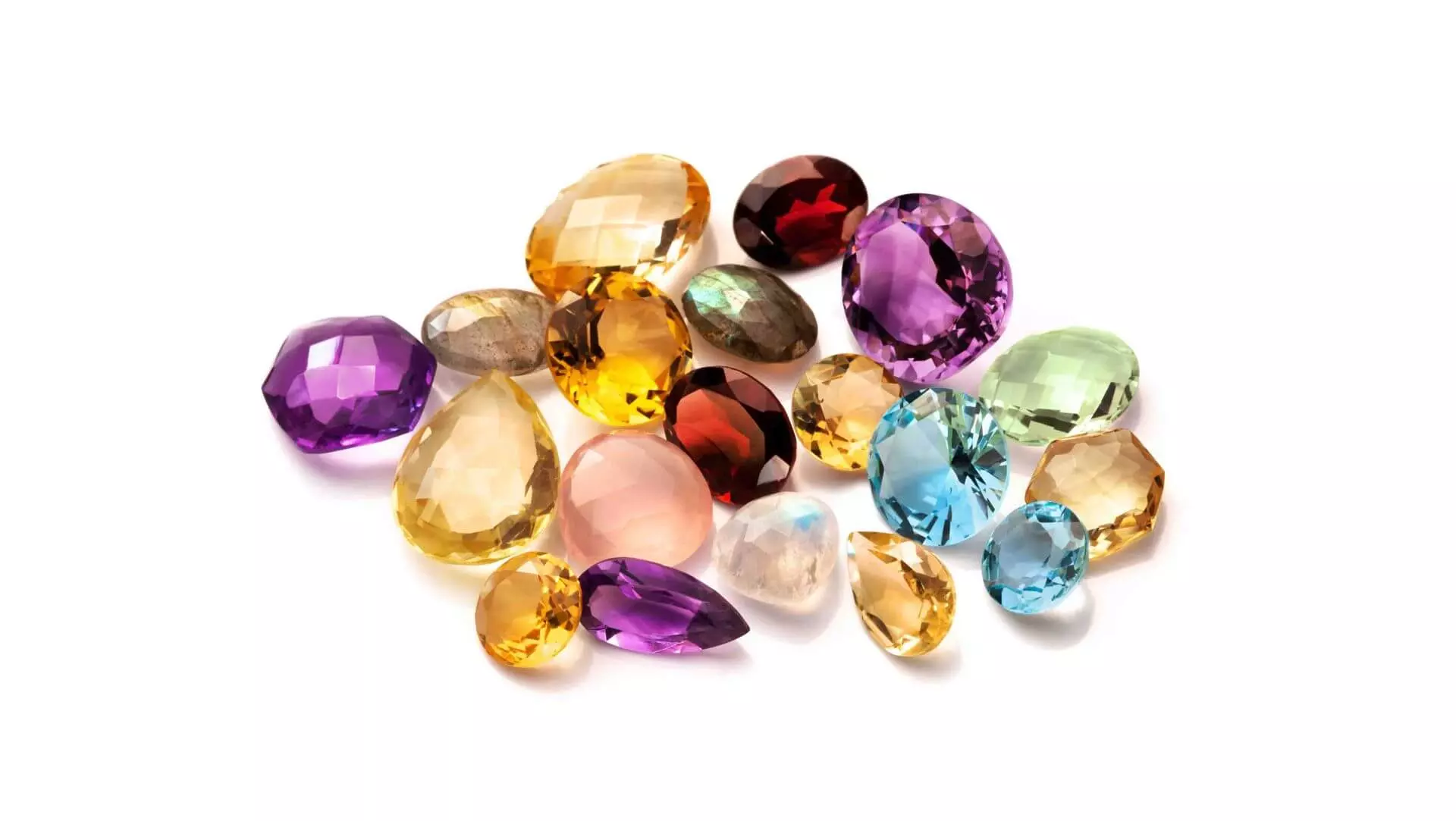Step into the vibrant realm of gemstones, where nature's artistry meets human craftsmanship. This guide unravels the complex tapestry of gemmology, shedding light on the beautiful mysteries that lie beneath the surface of your favourite jewels. Whether you're a seasoned collector or a novice gem enthusiast, understanding these fundamentals is essential to appreciate the true value of these precious stones.
What is a gem?
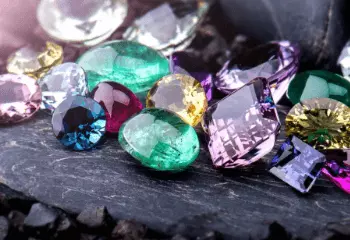
The world of gemstones offers such an endless choice of colour and variety of fascinating minerals that they can satisfy even the most difficult of people to please. The history of gemstones goes back for centuries since they were prized long before the diamond was discovered. Many prospectors in the past have risked their lives to find them and still today, although mining conditions in some areas have improved, people continue to put their lives at risk in the search for the most beautiful, naturally created, specimens from earth.
|
A Mineral is defined as: |
|
A solid crystalline chemical element or compound that results from the inorganic process of nature and that has a characteristic crystal structure and chemical composition or range of compositions. |
Within the mineral kingdom the most common characteristics of gemstones are: chemical composition and crystal structure, the combination of which, together with physical and optical properties, are most important in their identification. All minerals that have identical chemical composition (or range of compositions) and identical crystal structure are of the same Species.
There are more than 3500 known species to date and this number is increasing at each year but only a very small proportion of these minerals have the attributes which qualify them as gemstones: Beauty, Durability and Rarity!
For example, Quartz has the chemical composition of SiO2 (known as silica) and a hexagonal crystal structure. It is one of the most common minerals. It is part of many common rocks including granite, but also forms in varieties classified as gems:
| Variety Amethyst: | blueish-Purple to Purple to reddish-Purple. |
| Variety Citrine | Yellow to Orange to brownish-Orange |
Just some quartz varieties: Rock-crystal, Tiger’s eye, Aventurine, Citrine, Smokey, amethyst!
Corundum is another well-known species with many varieties including sapphire & ruby, but different varieties of corundum have dramatically different prices! The key factors that affect a gems value are: Colour, Clarity, Carat Weight and Cut
Colour
In Corundum for example, the Sapphire variety comes in a rainbow of colours ranging from Pinks, Oranges, Yellows, Purples, Greens and even Golden colour.
Ruby, on the other hand, is Red. Ruby is far rarer that other colours of corundum and therefore far more valuable. In the past, pink was thought to be light red and many pink gems were called Ruby (and priced as such!) Padparadscha is the only other variety name given to one of the rarest of the corundum family, it is a blend of Pink and Orange which is quite unique and valuable.
With colour having such an effect on value, since the beginning of the twentieth century gemmologists have created clear means of assessing colour and now prefer to avoid confusion in value and rarity, for example calling Pink corundum, Pink sapphire instead of ruby!
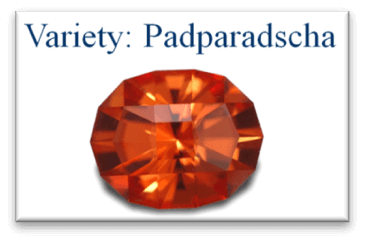
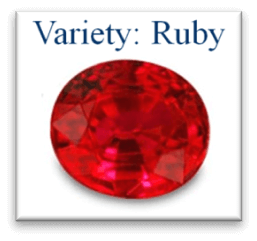
Gemmologists don’t just talk about colour, but break down this important factor into four elements:
- Hue: The predominant colour (wavelength)
- Tone: The shade of colour (light to dark)
- Saturation: The intensity or vividness of colour
- Evenness of colour: The absence of colour zoning
Let’s take the Blue Sapphire as an example.
There are differences in opinion as to what is the ‘Best’ Blue. Some prefer just Blue while others will insist that a slightly violets-Blue is a superior colour. However, most people in the industry agree that greenish-Blue sapphires are definitely less valuable. You should always keep in mind that personal preference is most important. When buying any gems remember you will be the one to see it, wear it and enjoy it every day.
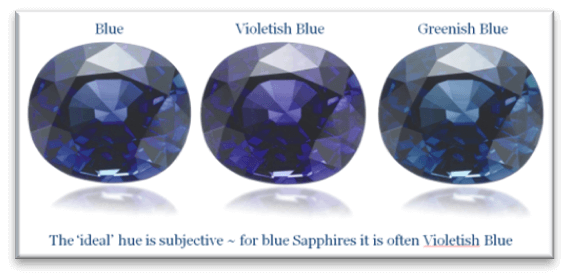
The next is tone, how light or dark the colour appears. In some gems the tone can influence the variety name and therefore raise cause to command a distinctly different price! The light tone changes the classification of the stone to Pink sapphire – from the more valuable Ruby, whose tone must be medium to dark.
Where tone is ‘light to dark’, saturation refers to the intensity of the colour, or vividness. A gem with weak saturation appears washed out whereas the more saturated the colour the more vivid, vibrant & expensive!
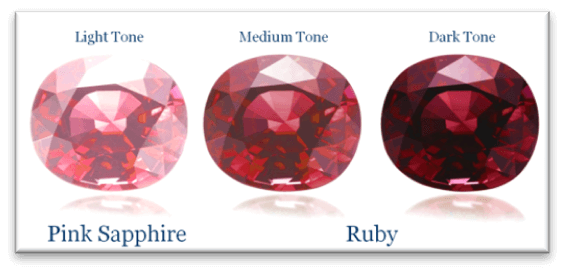
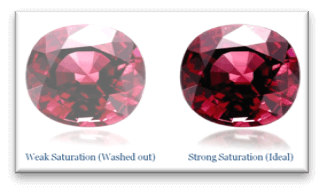
Finally, evenness of colour is another feature to look for especially in Rubies and Sapphires as many are prone to exhibit colour zoning - Lighter and darker bands of colour running through the gem. Many gems exhibit colour zoning which if easily noticeable will lower the value.

Sapphires which are not such good Hue, very dark, not vivid and with colour zoning are plentiful in the marketplace today! Just because it is a sapphire does NOT mean it is rare or expensive! You can use your understanding of colour, and the terms used by gemmologists to better negotiate your next purchase since gemstone sellers will treat you differently if they know you understand the factors that affect a gems value!
Clarity
Clarity refers to the number and type of internal and external characteristics in a gemstone: Internal Characteristics are called ‘Inclusions’ (NOT imperfections!) and External Characteristics are called ‘Blemishes’. These characteristics affect the value of the stone but are not always bad! In many cases they allow gemmologists to identify genuine gems and even establish whether they were formed naturally!
There are many different clarity grading systems worldwide by many different agencies. One of the most popular is the Gemmological Institute of America that breaks down gemstones into 3 clarity categories:
|
Type 1 |
Type 2 |
Type 3 |

Normally clean to the naked eye. Few Characteristics under 10x magnification |
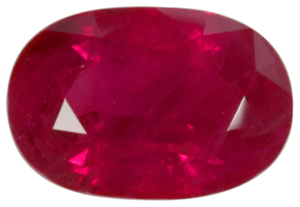
Few characteristics visible to the naked eye. Clearly visible under 10x magnification |

Many clear characteristics visible to the naked eye. Clearly visible under 10x magnification |
|
Eg: Aquamarine, Topaz |
Eg: Ruby, Sapphire |
Eg: Emerald, Rubellite |
While clarity is important in all gems, this factor has less weight than colour and especially for the type 2 and type 3 stones. It is only in colourless gems like Diamond that clarity becomes especially important.
Carat Weight
The carat is a standard measure of weight in gems. The term Carat originated from the carob seed, used since the earliest gem dealings.
The metric system standards for carat weight
were developed in 1913 and equate 1 carat to 0.2 grams. They also divide 1 carat into 100 points.
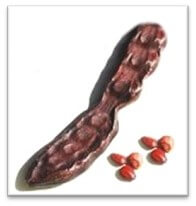
As gems increase in carat weight the price per carat increases dramatically up to a certain size. Once a gemstone becomes unwearable due to its size – the price per carat tends to drop. This means a one 1ct stone will be much more valuable than two 50-point stones.
Cut
For most gems in the market, cutting is still done by hand! India (Gujarat and Surat) and Thailand (Chanthaburi) are some of the largest cutting centres for gemstones where skilled craftspeople apply each facet one-at-a-time to create the gems we buy today.

Common shapes for different gems are usually determined by how to retain the greatest weight from the rough
crystal; for example, in diamonds, this would be the round shape, in ruby it would be the oval.
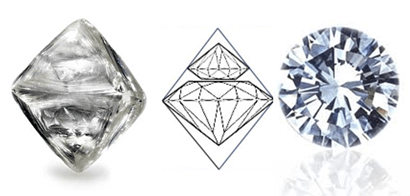
For unusual rough however, cutters have invented many beautiful cutting styles and with modern technologies, some gems can even be cut into unusual customized shapes!

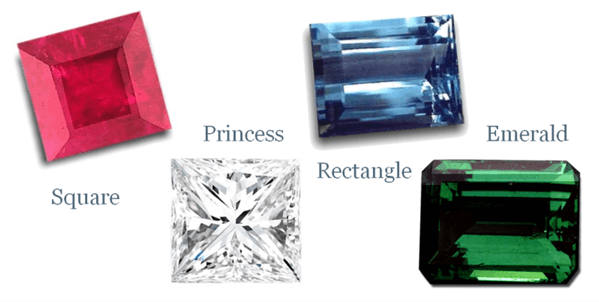
The Proportions in cutting gems refer to how deep or shallow the gem is and whether the table and culet or keel line are on or off centre. These measurements are very important!

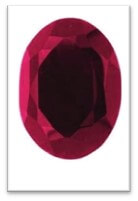
Stones which are very deep will be difficult to set or look smaller than they should. Often, they will look dark and have reduced brilliance.
A gem which is too shallow might have a large area where the stone becomes ‘see-through’ called a window. Major symmetry problems are not attractive and when easily noticed reduce value substantially.
Gem Simulants
A gemstone Simulant can be described as any material which resembles another, (usually more popular) gemstone, in appearance.
Imitations have existed since the earliest of times and before a system to scientifically classify different types of species was devised most green gems were called Emerald and red gems were called Ruby. These Imitations were either natural gems of a similar colour or glass.
Synthetic gemstones can also be imitations (e.g. Colourless synthetic Spinel or synthetic Rutile are Imitations of Diamond.) Assembled stones and even Plastic can imitate a variety of other well-known Natural gemstones.
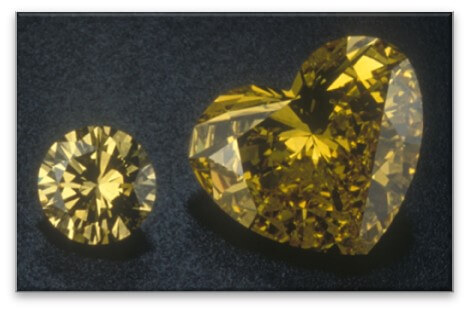
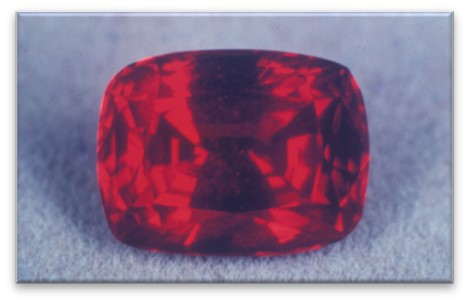
While there are some simple ways to gauge the authenticity of some simulants, often, identifying a simulant requires equipment, practice and experience. As a lay person, you might look for ‘clues’ that don’t fit the quality of the gem you are buying – for example, if you are buying an expensive diamond, yet when you look at the cutting of the gem, it appears poorly cut, or with rounded or scuffed facets, then you might want to do some more investigating before you make a purchase decision!
Experts will examine closely the characteristics of the gemstone: By examining measurable properties like refractive index, refraction, specific gravity, etc, they will conclude about the material they are testing. Most natural gems also have difficult-to-reproduce characteristics that indicate their natural formation.These gems also do not contain gas bubbles – a common give-away in simulants made from glass.
Assembled Gems
Beyond simple substitution, another of the common imitation gems are the assembled stones sometimes referred to as Composite stones of which there are two main types: Doublets and Triplets.
Doublet is a combination of two materials - typically a gem quality material on the top and an inferior material below.
Triplet refers to the use of coloured cement or third coloured layer in-between typically colourless upper & lower portions.
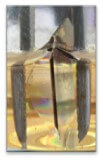
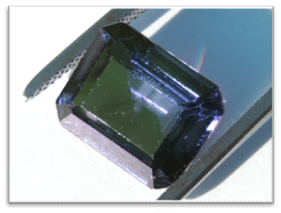
There is no doubt by the way they are cunningly created that the purpose behind most assembled stones (unlike many other Imitations) is to deceive the gem buyer.
Doublets may be reliably detected by immersion in a liquid with an index of refraction like that of the gem fragments; the layer of cement will appear as a dark line. Jewellers will typically use a 3.32 specific gravity liquid (Methylene Iodide) due to its refractive index. But there is no easy way for the lay person to spot these!
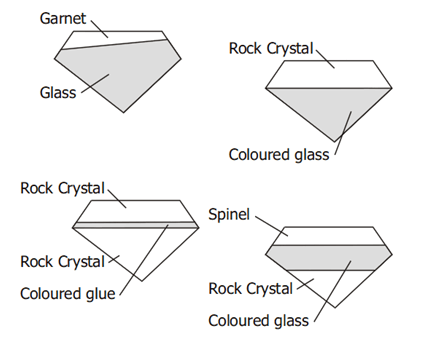
Synthetic Gems
A Synthetic Gemstone has essentiality the same chemical composition, crystal structure and consequently the same physical and optical properties as the natural gem it represents with the difference that it is made by Man in a laboratory and not by Nature.
Synthetic gems are most often used for legitimate purposes – ranging from watch components to lower-cost jewellery and it is rare that they are substituted for natural gems.
When they are, however, this poses a serious concern to the jewellery industry and gem-buying public since, having the same chemical composition and crystal structure, these gems have the same characteristics and attributes as their natural counterparts and are very difficult to detect!
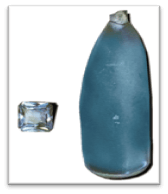
Recently however, detection technology is improving, and most international gem labs can spot tell-tale signs of synthetic gems when these gems are sent for identification or grading.
Some jewellery firms even use synthetic gemstones to their marketing benefit – presenting them as ‘cultured gems’ and offering them at a substantial price reduction over their natural counterparts for the price conscious buyer.
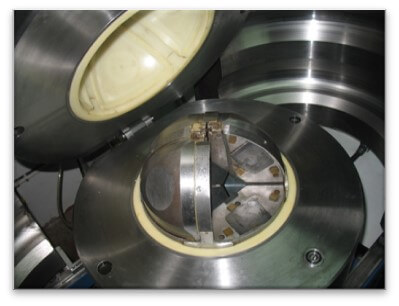
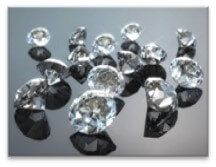
As we conclude our exploration of gemmology fundamentals, we hope you now feel more enlightened and confident as a gem buyer. The knowledge of what truly makes a gemstone valuable - its colour, clarity, carat weight, and cut - is your strongest asset when navigating the gem market. With this newfound understanding, may every piece you choose not only sparkle with aesthetic beauty but also resonate with the rich stories of nature and craftsmanship that each gem carries within. But why stop here? With JDMIS' GT100 - Gem and Jewellery Trade Secrets Certification course, you can delve even deeper. Discover the industry's best-kept secrets, learn from renowned experts, and transform your passion into expertise. Don't miss this golden opportunity to elevate your understanding of gemstones and jewellery to professional heights. Visit the GT100 course page and take your first step towards becoming a certified gem connoisseur today!
Tanja M. Sadow G.J.G.
Dean and founder of the Jewellery Design and Management International School
